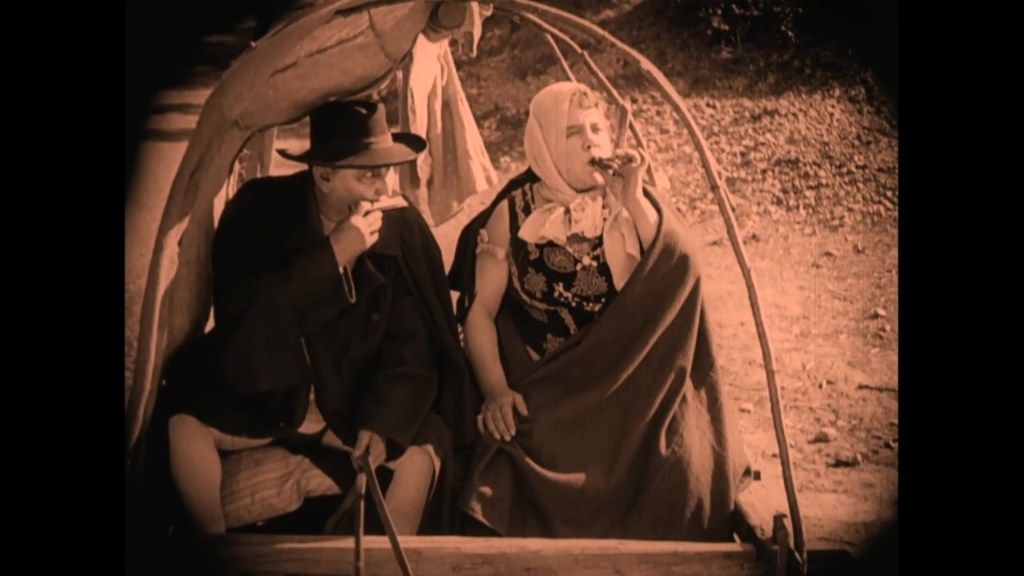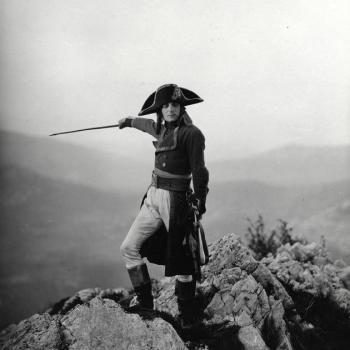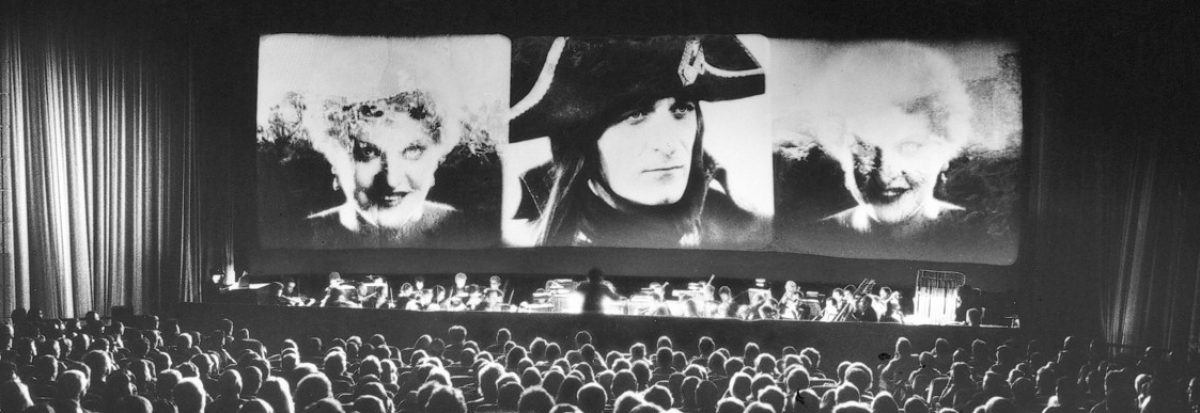I saw the film via the streaming service of the Bonn International Silent Film Festival this summer. I didn’t make many notes “live”, so what follows is not as detailed as previous entries…
Gunnar Hedes saga (1923; Swe.; Mauritz Stiller)
Gunnar Hedes wants to be a musician, but his father dies and his mother wants him to go into business to save the family house. But when Gunnar falls for the orphan Ingrid, he decides to choose music over business and embarks on a wild scheme to win a fortune by herding reindeer…

The opening titles tell us the film is “freely adapted” from Selma Lagerlöf’s novel by Mauritz Stiller. It’s always interesting to see the way a filmmaker can insert their name into the credits when adapting a literary text. Given the tense relationship between these two authors, it’s no wonder that Stiller had to emphasize his artistic license from the outset. It’s a boast and an excuse.
Little Gunnar dreams of his grandfather the fiddler and legendary reindeer-rustler, whose portrait hangs on the wall of the Munkhyttan estate house. Miss Stava, the family’s old housemaid—who almost stands in for a kind of Lagerlöf -style female narrator—tells Gunnar the tale of his grandfather. The picture on the wall comes alive: within the inner frame, the grandfather plays his violin; beyond the inner frame, a vision of reindeer fills the rest of the film’s frame. It’s a neat encapsulation of Stiller’s art: exterior spaces flooding into the interior world of the boy’s physical and imaginative space. It also encapsulates the functions of the film’s music: bringing to life pictures in the frame. If the boy longs for an escape from reality, we soon understand why. For Gunnar’s reality is a world where the bourgeois adults (as exemplified by his mother) are cold, judgemental, and restrictive. “Gunnar is not going to be a violin player and a dreamer, but a practical man, who can one day take over Munkhyttan!”


Cut to the adult Gunnar (Einar Hansson), who is forced to study mining instead of his beloved music. A letter arrives, dragging him back home: his father is dying. We see the father die, but the following scenes are missing—so the restoration gives us just the titles, which survive without a visual context. There is something moving in the way the film offers just these intertitles. We read, then, that the father has left debts, and that the estate must get rid of some of its staff. The falling apart of Munkhyttan is given a kind of reconstructive equivalent by the missing footage.

The Blomgrens—travelling performers—arrive with an orphan they have taken in. She is Ingrid (Mary Johnsson). The Blomgrens are the antidote to the Hedes: free-talking, freewheeling, artistic. Even their horse, Lady Hamilton, has personality: she doesn’t budge without a musical soundtrack, so the Blomgrens must take it in turn to play the harmonica while they travel.

When the performers arrive in the courtyard of Munkhyttan, Gunnar is daydreaming of his grandfather playing the violin: his tiny figure appears superimposed on the desk. But he is woken by reality: it is Ingrid playing the violin. Gunnar races downstairs and joins in, playing the waltz from Gounod’s Faust and nicknaming Ingrid “Marguerite”. He explains that she was “a young girl who loved Faust and saved his soul with her love.” (Hint, hint.)



Gunnar’s mother comes outside and smashes the violin. Not just that, she stamps on it. It’s a great scene, and a brutal assertion of parental power. Realizing it was Ingrid’s violin and not her son’s, she instead gifts Gunnar’s violin in its stead: an act of spite disguised as an act of charity. Mother and son have a furious argument. Ingrid enters, hoping to return the violin to Gunnar, but falls in a faint at the family’s feet. She is taken in by the estate’s old steward, while Gunnar’s mother ejects him from Munkhyttan without a penny.

Gunnar takes up as a strolling musician and, on a train, ends up entering into a business deal with strangers to herd reindeer in order to make a quick profit. There follows a long section of the film in which we follow the reindeer herd across stunning landscapes. The film’s main set piece takes place when a snowstorm strikes and the lead reindeer makes a dash for it, dragging Gunnar across the frozen landscape and depositing him in a snow drift. When he wakes, he hallucinates a vision in the horns of a deer. The vision is, frankly, confusingly rendered via superimposition: it represents a fire at Munkhyttan, where Gunnar’s mother is trying to beat Ingrid. I wonder if this scene is in the novel (Lagerlöf liked her premonitions, so it strikes me as possible): it feels shoehorned into the scene. It didn’t relate convincingly to the rest of the film.




Ingrid’s own vision in the next scene is more interesting: the vision of an old woman as the personification of sorrow gives Stiller the chance to play with interior/exterior spaces. The woman and her bear-drawn sled appear to dissolve as a vision into Ingrid’s room, but (in reality, as a production still suggests) the bed has surely been relocated into the exterior space itself. (The wall dissolving away is an exceedingly brilliant effect.) Stiller cuts between a medium shot of Ingrid with the sled in the background to close-ups of Ingrid with the bedroom behind her: she is weirdly in these two spaces at the same time. The sled then appears inside the room itself, and slides out of frame as if further into the house, completing this strange transformation of spaces.



As elsewhere in the film (and in Lagerlöf’s work, and Stiller’s adaptations thereof), the vision is a premonition. As Gunnar is revealed being borne by misfortune, so Gunnar returns to Munkhyttan in a state of mental derangement. He refuses to sleep in the main house and soon escapes into the countryside. There is a lovely scene where he stares at his reflection in a river, and where he is found by Ingrid—the only person he seems to trust. Together they gather some gleaming rocks, which Gunnar believes are coins. He hopes to buy back Munkhyttan, which is being sold off by his distraught mother for want of funds.



But despite the time he spends with Ingrid, Gunnar is divorced from reality. In despair, as Munkhyttan is about to be sold, Ingrid tries to drown herself—but is rescued by the Blomgrens, who are once more on their summer tour. The scene is set for a return to the start of the film: this time it is Ingrid who plays the music from Faust, and it is this music which awakens Gunnar from his mental torpor. Gunnar’s mother finally blesses bother her son and Ingrid, and the Munkhyttan estate is miraculously saved: the rocks Gunnar gathered when mad are in fact valuable, and enable a new mining operation to bring them a fortune. The End.



A good film? Yes, but not a great one. If my description of Gunnar Hedes saga is less lengthy than with previous posts, it’s because I found the film less interesting than many I’ve watched recently. Perhaps it would make a difference if more of the film survived: only 70 minutes remain from the original 100. Would the various premonitions/visions have made more sense with more scenes around them? Perhaps, but I don’t think my wider reservations would be solved with more plot. I didn’t find the story especially engaging, and I was moved only occasionally. Likewise, I found the performances only occasionally moving. This film was Einar Hansson’s first leading role, and he only got it because Lars Hanson proved unavailable for the film. Perhaps this was a happy accident, for Einar Hansson is a much more boyish Gunnar than Hanson would have been. (The former was thirteen years younger than the latter.) Through Hansson, I can believe in Gunnar’s youthful enthusiasms, and he has a kind of sad, silly charm when playing mad in the latter half of the film. But I find Mary Johnsson rather stiff and doll-like. Her way of holding a gesture for too long, even her stilted way of playing the violin, inhibited rather than evoked feeling. Her performance often made it difficult to feel for her, or to believe in her inner life and emotions. I don’t think it’s her fault: she’s clearly been asked to perform this way. The sheer beauty of the way she is filmed almost underlines the limitations of the performance: the cinematography is lavishing so much attention on her face and hair that it forgets that more is needed to move the viewer.

But I should spend more time on the cinematography, which is stunning. Julius Jaenzon was the great cameraman of Sweden’s “golden era” of the 1910s-20s, and his work here is superb. I’ve mentioned the close-ups of Johnsson, which are often breathtakingly beautiful (aesthetically, yes, but not emotionally engaging for the drama itself). But the real stars of the film are the landscapes. The reindeer herding scenes contain some extraordinarily beautiful exteriors. Jaenzon captures the light shining off water, snow, and rock in an almost unearthly way. The tinting makes everything gleam and glow, while also enhancing the texture of the elements. I’d love to see these scenes on a big screen.




And I’d love to know what music was intended to accompany the film. The Bonn performance I saw streamed featured excellent music for violin and piano, as played by Günther Buchwald and Neil Brand. Sadly, the only soundtrack to accompany the film in its official online life (on the Swedish archive site www.filmarkivet.se) is by Helmer Alexandersson, which is more of an acoustic wash than a composed score. It’s reverbed to the max, leaving you with a dreamy, echoey drowsiness that quickly disintegrates in the memory. It’s like musical mulch. Not even the blizzard sequence awakens the soundtrack into more than a few deeper washes of sound. More to the point is that the music specifically cited by the film (and played on screen) is not used in the Alexandersson score. Buchwald/Brand carefully cite Gounod’s melody when required, and work the piece into their score in a very effective way. Why couldn’t Alexandersson? It’s not as if Gounod presents a copyright issue. (It’s a bugbear of mine when new scores ignore the music on screen. For example, the TCM restoration of The Mysterious Lady (1928) issued on DVD has a score by Vivek Maddala that ignores the music from Puccini’s Tosca that is shown being performed on screen, first in a theatrical performance and later on the piano. The opera is a thematic touchpoint of the film and to substitute it with something else—not to mention something infinitely blander—is baffling. I’m lucky to have seen the film performed with Carl Davis’s score, which quotes from Tosca and is by far and away musically superior.)
But one point to raise is with the choice of Gounod itself. A brief search in the text of the original novel seems to suggest that Lagerlöf made no mention of Faust, so perhaps the musical motif was one invented by Stiller. (Lagerlöf was unhappy with Stiller’s changes to her text, to the point of threatening to publicly disown her involvement with the film. Not having read the novel, I am unable to say which changes are obvious.) Gounod’s melody is a famous one, but also superficial: it’s a repetitive dance motif. It’s famous enough to be recognizable when played in the scene (and in the cinema) but it’s not a piece with any emotional weight. Indeed, Gounod’s opera had become a sort of joke for bourgeois taste: by the end of the nineteenth century, it was one of the most-performed operas ever written. In Germaine Dulac’s La Souriante Madame Beudet (1923), the artistic wife plays Debussy at the piano while her boorish husband wants to go and hear Gounod’s Faust in the theatre. (Dulac even gives us a visual parody of the singers belting out tunes that were by now a kind of cultural cliché.) The kind of cultural division between Gounod (bourgeois, populist) and Debussy (refined, modernist) is a key marker of the divide between husband and wife in Dulac’s film. (And yes, Madame Beudet is another film where the new score, by Manfred Knaak, doesn’t bother citing the music being played on screen.) Stiller’s film was released in the same year at Dulac’s, and it’s curious to observe the way these films use Gounod in very different ways. The fact that the climactic emotional scene in Gunnar Hedes saga is achieved through the citing of a banal piece of music seems odd, and contributes to the reasons why I wasn’t as moved as I felt I could and should have been. The idea of a Marguerite saving Gunnar’s soul was cited rather than developed, and the well-worn melody seemed to suit the facile way the film wrapped itself up.
So, in sum, a film worth seeing—but mostly for the exteriors, where Stiller (like Gunnar) seems freer to express himself, and where Julius Jaenzon’s cinematography is at its very best.
Paul Cuff

